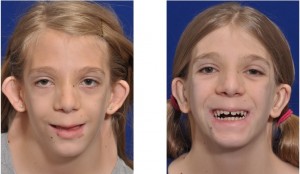

Recently, a mutational analysis of MPS without CHRNG mutations has been reported: no CHRNA1, CHRNB1, or CHRND mutations were found, but a homozygous RAPSN frameshift mutation (c.1177-1178 del A) was identified in a family with three members affected by lethal fetal akinesia ( Vogt et al., 2008). A baby with Escobar syndrome does not show marked muscle weakness or myasthenic syndrome because the γ subunit is not required postnatally. Deficiency of embryonic AChR γ subunit, which is present at the fetal neuromuscular junction until the 31st gestational week and is then replaced by adult AChR ε subunit, explains fetal akinesia. Recently, mutations in the embryonic AChR γ subunit were identified in approximately 30% of lethal MPS, and also in nonlethal Escobar variant MPS ( Hoffmann et al., 2006 Morgan et al., 2006). MPS are phenotypically and genetically heterogeneous but are divided into prenatally lethal and nonlethal (Escobar) types. Multiple pterygium syndromes (MPS) comprise a group of multiple congenital anomaly disorders characterized by webbing of the neck, elbows and/or knees, and joint contractures. Brigitte Estournet, in Handbook of Clinical Neurology, 2013 Fetal akinesia and multiple pterygium syndromesįetal akinesia and multiple pterygium syndromes may be caused by CHRNG and RAPSN mutations. This so-called ascertainment bias in Turner syndrome has profound implications for prenatal counseling.īruno Eymard. Whereas a 45,X fetus identified prenatally has a prognosis similar to that of a child with Turner syndrome diagnosed postnatally, approximately 90% of fetuses in whom a 45,X/46,XX or 45,X/46,XY karyotype is incidentally diagnosed prenatally will have a normal female or male phenotype at birth. Affected fetuses often abort spontaneously.

Turner syndrome may be diagnosed prenatally on the basis of a variety of ultrasound findings (increased nuchal translucency, lymphedema, cystic hygroma, coarctation of the aorta, renal anomalies) or by abnormal results of fetal karyotyping. The presence of Y chromosomal material is of critical importance in patients with Turner syndrome because it predisposes them to potential masculinization and gonadoblastoma ( Fig. Mosaicism-the presence of two or more chromosomally different cell lines-occurs in 30% to 40% of these patients, the majority (10% to 15%) being 45,X/46,XX and 2% to 5% being 45,X/46,XY ( Zinn et al, 1993). From 12% to 20% of patients with Turner syndrome have an isochrome X (duplication of one arm of the X chromosome with loss of the other arm). One-half of the patients have a 45,X karyotype in all cells this is believed to be secondary to loss of an X chromosome through nondisjunction in gametogenesis or an error in mitosis. Turner syndrome has an incidence of 1 in 2500 live births. Deletions in the short stature homeobox (SHOX) gene located on the pseudoautosomal region of the X and Y chromosomes have been suggested as the basis for the short stature in this syndrome. The diagnosis of Turner syndrome should be considered in any infant with lymphedema or any young woman with short stature or primary amenorrhea. The severity of phenotypic features does not necessarily correlate with karyotypic findings. But the clinical features of Turner syndrome are quite variable, and almost any combination of physical features may be seen with any X chromosomal abnormality. Turner syndrome, with a 45,X karyotype, is associated with four classic features: female phenotype, short stature, lack of secondary sexual characteristics, and a variety of somatic abnormalities. The other sex chromosome may be absent or abnormal, or mosaicism may be present. Subsequent chromosomal studies showed that Turner syndrome is characterized by the presence of only one normally functioning X chromosome ( Ford et al., 1959). It was not until 1959 that Ford recognized that one missing X chromosome was the etiologic basis for the syndrome. Subsequently, gonadal dysgenesis was recognized as part of this syndrome ( Hall and Gilchrist, 1990).

In 1938, Henry Turner described the combination of sexual infantilism, webbed neck, and cubitus valgus (increased carrying angle at the elbows) as a distinct entity. Partin MD, PhD, in Campbell-Walsh-Wein Urology, 2021 Turner Syndrome


 0 kommentar(er)
0 kommentar(er)
